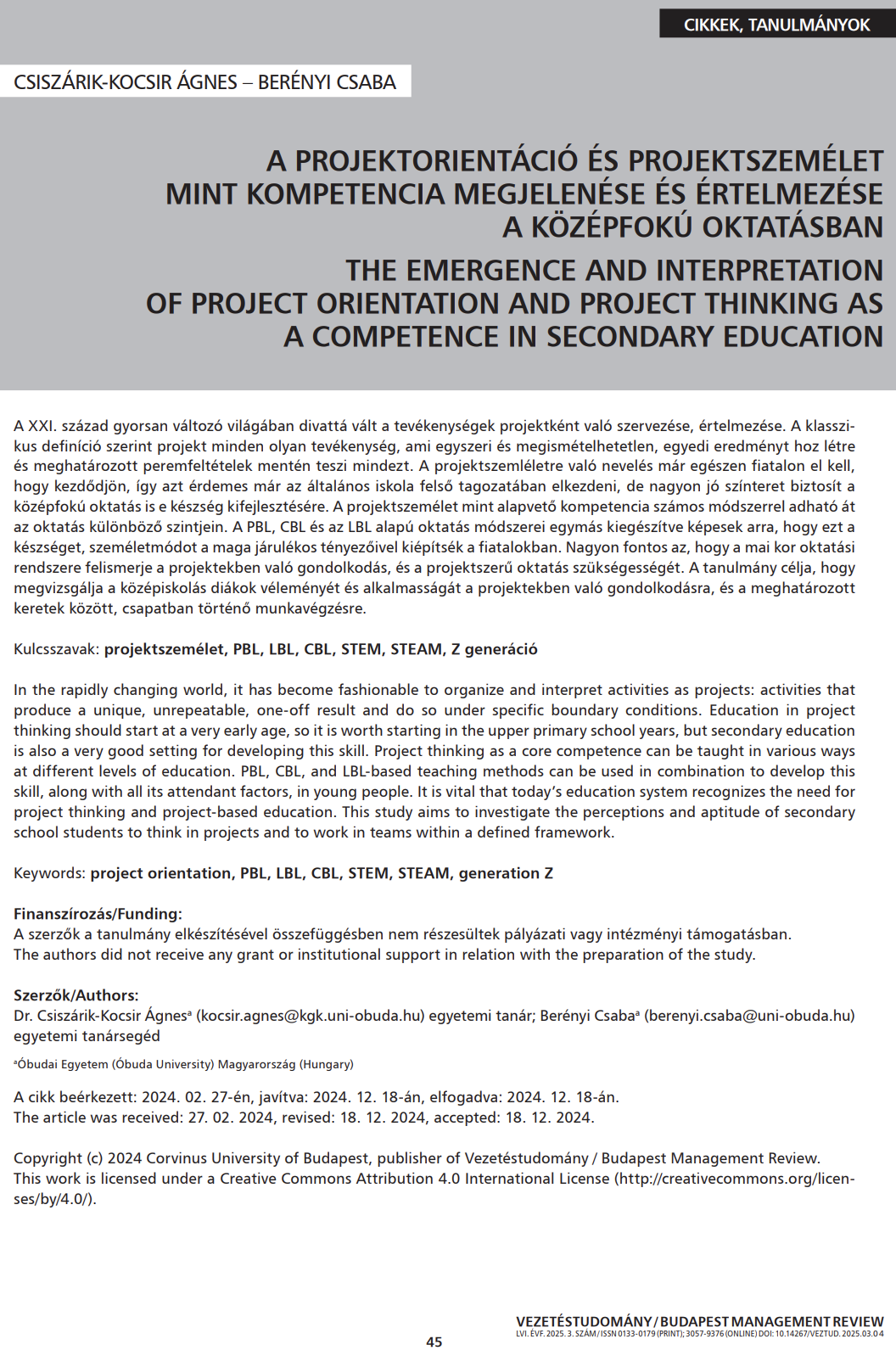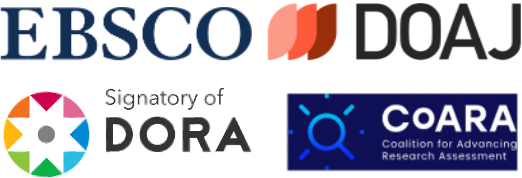The emergence and interpretation of project orientation and project thinking as a competence in secondary education
DOI:
https://doi.org/10.14267/VEZTUD.2025.03.04Keywords:
project orientation, PBL, LBL, CBL, STEM, STEAM, generation ZAbstract
In the rapidly changing world, it has become fashionable to organize and interpret activities as projects: activities that produce a unique, unrepeatable, one-off result and do so under specific boundary conditions. Education in project thinking should start at a very early age, so it is worth starting in the upper primary school years, but secondary education is also a very good setting for developing this skill. Project thinking as a core competence can be taught in various ways at different levels of education. PBL, CBL, and LBL-based teaching methods can be used in combination to develop this skill, along with all its attendant factors, in young people. It is vital that today’s education system recognizes the need for project thinking and project-based education. This study aims to investigate the perceptions and aptitude of secondary school students to think in projects and to work in teams within a defined framework.
Downloads
References
Aidoo, B. (2023). Teacher Educators Experience Adopting Problem-Based Learning in Science Education. Education Sciences, 13(11), 1113. https://doi.org/10.3390/educsci13111113
Akkerman, S.F., & Meijer, P.C. (2011). A dialogical approach to conceptualizing teacher identity. Teaching and Teacher Education, 27(2), 308-319. https://doi.org/10.1016/j.tate.2010.08.013
Alrajeh, T.S. (2021). Project-based learning to enhance pre-service teachers’ teaching skills in science education. Universal Journal of Educational Research, 9(2), 271-279. https://doi.org/10.13189/ujer.2021.090202
Annet J., & Stanton, N.A. (2000). Team work: A problem for Ergonomics? Ergonomics, 43(8), 1045-1051. http://doi.org/10.1080/00140130050084860
Beckett, G.H. (1999). Project-based instruction in a Canadian secondary school’s ESL classes: goals and evaluations (T). University of British Columbia. https://open.library.ubc.ca/collections/ubctheses/831/items/1.0078180, https://doi.org/10.14288/1.0078180
Bencsik, A., Horváth-Csikós, G., & Juhász, T. (2017). Az Y és a Z generációval szembeni előítéletek a munkahelyen. Taylor, 9(2), 121-128. https://ojs.bibl.u-szeged.hu/index.php/taylor/article/view/13108
Benton, L., Varotsis, G., & Vasalou, A. (2019). Leading by example: Exploring the influence of design examples on children’s creative ideation. International Journal of Human-Computer Interaction, 122, pp. 174–183. https://doi.org/10.1016/j.ijhcs.2018.09.007
Blumenfeld, P.C., Soloway, E., Marx, R.W., Krajcik, J.S., Guzdial, M., & Palincsar, A. (1991). Motivating Project- Based Learning: Sustaining the Doing, Supporting the Learning. Educational Psychologist, 26(3-4), 369-398. https://doi.org/10.1080/00461520.1991.9653139
Breiner, J.M., Harkness, S.S., Johnson, C.C., & Koehler, C.M. (2012). What is STEM? A discussion about conceptions of STEM in education and partnerships. School Science and Mathematics, 112(1), 3-11. https://doi.org/10.1111/j.1949-8594.2011.00109.x
Brown, R., Brown, J., Reardon, K., & Merrill, C. (2011). Understanding STEM: Current perceptions. Technology and Engineering Teacher, 70(6), 5-9. https://www.STEM_Current_perceptions#fullTextFileContent Bybee, R.W. (2010). Advancing STEM education: A 2020 vision. Technology and Engineering Teacher, 70(1), 30-35.
Bybee, R.W. (2013). The case for STEM education: Challenges and opportunities. National Science Teachers Association.
Capraro, M.M., & Jones, M. (2013). Interdisciplinary STEM Project-Based Learning. In Capraro, R.M., Capraro, M.M., & Morgan, J.R. (Eds.), Project-Based Learning: An Integrated Science, Technology, Engineering, and Technology (STEM) Approach (pp. 51- 58). Sense Publishers. https://doi.org/10.1007/978-94-6209-143-6_6
Cavas, B., Karaoglan, B., & Cavas, P. (2004). The Use of Information Communication Technologies in Primary Science Education: A New Teaching and Learning Approach. Journal of Turkish Science Education, 1(2), 72-84.
Carvalho, C., Fiuza, E., Conboy, J., Fonseca, J., Santos, J., Gama, A.P., & Salema, M.H. (2015). Critical Thinking, Real Life Problems and Feedback in the Sciences Classroom. Journal of Turkish Science Education, 12(12), 22-31. https://doi.org/10.12973/tused.10138a
Cilliers, E.J. (2017). The Challenge of Teaching Generation Z. PEOPLE: International Journal of Social Sciences, 3(1), 188-198. https://doi.org/10.20319/pijss.2017.31.188198
Clark, R.E., Feldon, D., van Merrienboer, J.J.G., Yates, K, & Early, S. (2007). Cognitive Task Analysis. In Spector, J.M., Merrill, M.D., van Merriënboer, J.J.G., & Driscoll, M.P. (Eds.). Handbook of research on educational communications and technology (3rd ed.) (pp. 578-593). Lawrence Erlbaum Associates.
Csepeli, G., Kígyós, É., & Popper, P. (2006). Magára hagyott generációk: fiatalok és öregek a XXI. században. Saxum.
Csiszárik-Kocsir, Á. & Varga, J. (2017a). Financial knowledge, skills and investment practice in Hungary – results based on a primary research. Macrotheme Review: A Multidisciplinary Journal of Global Macro Trends, 6(4), 10-20.
Csiszárik-Kocsir, Á. & Varga, J. (2017b). The Hungarian SMEs’ Project Financing Practice – Results Based on a Primary Research. In Kolakovic, M. (Eds.), Proceedings of 2nd Business & Entrepreneurial Economics (BEE 2017) Conference (pp. 163-169). University of Zagreb, Faculty of Economics and Business.
Csiszárik-Kocsir, Á., Varga, J., & Saáry, R. (2022). The Scene and Importance of Teaching the Project Approach in the Light of the Results of a Hungarian Questionnaire Research. Eurasia Proceedings of Science Technology Engineering and Mathematics, 24, 45-52. https://doi.org/10.55549/epess.1179347
Daugherty, M.K. (2013). The Prospect of an “A” in STEM Education. Journal of STEM Education, 14(2), 10-15. https://www.jstem.org/jstem/index.php/JSTEM/article/view/1744/1520
Dominguez, C., & Jaime, A. (2010). Database design learning: A project-based approach organized through a course management system. Computers & Education, 55(3), 1312-1320. https://doi.org/10.1016/j.compedu.2010.06.001
Garai-Fodor, M. (2021). Food Consumption Patterns, in a Values-based Approach, for Generation Z. Acta Polytechnica Hungarica, 18(11), 117-134. https://doi.org/10.12700/APH.18.11.2021.11.7
Garai-Fodor, M. (2022). The Impact of the Coronavirus on Competence, from a Generation-Specific Perspective. Acta Polytechnica Hungarica, 19(8), 111-125. https://doi.org/10.12700/APH.19.8.2022.8.7
Garai-Fodor, M. (2023). Analysis of Financially Aware Consumer Segments from the Perspective of Conscious Consumer Behaviour. Acta Polytechnica Hungarica, 20(3), 83-100. https://doi.org/10.12700/APH.20.3.2023.3.6
Garai-Fodor, M., & Popovics, A. (2023). Analysing the Role of Responsible Consumer Behaviour and Social Responsibility from a Generation Specific Perspective in the Light of Primary Findings. Acta Polytechnica Hungarica, 20(3), 121-134. https://doi.org/10.12700/APH.20.3.2023.3.8
Han, S.Y., Yalvac, B., Capraro, M.M. & Capraro, R.M. (2015). In-service Teachers’ Implementation and Understanding of STEM Project Based Learning. Eurasia Journal of Mathematics, Science and Technology Education, 11(1), 63-76. https://doi.org/10.12973/eurasia.2015.1306a
Helmich, K. (2008). A generativitás fogalma és a nemzedékek egymásra hatása. In Gyáni G., & Láng M. (Eds.), Generációk a történelemben (pp. 115-120). Hajnal István Kör–Társadalomtörténeti Egyesülete és a Nyíregyházi Főiskola Gazdasági Társadalomtudományi Kara.
Jäckel, K, & Garai-Fodor, M. (2023). What represents value and happiness for the Hungarian Generation Z in 2022-2023? In Szakál, A. (Eds.) IEEE 17th International Symposium on Applied Computational Intelligence and Informatics (SACI) (pp. 297-302). IEEE Hungary Section. https://doi.org/10.1109/SACI58269.2023.10158648
Kaufman, D.M. (2003). Applying educational theory in practice. BMJ Clinical Review, 326(7382), 213–216. https://doi.org/10.1136/bmj.326.7382.213
Khoshnevisasl, P., Sadeghzadeh, M., Mazloomzadeh, S., Hashemi Feshareki, R., & Ahmadiafshar, A. (2014). Comparison of problem-based learning with lecture- based learning. Iran Red Crescent Medical Journal, 16(5), 5186. https://doi.org/10.5812/ircmj.5186
Kokotsaki, D., Menzies, V., & Wiggins, A. (2016). Project- based learning: A review of the literature. Improving Schools, 19(3), 267-277. https://doi.org/10.1177/1365480216659733
Krajcik, J.S., & Czerniak, C.M. (2018). Teaching science in elementary and middle school: A project-based learning approach. Routledge.
Lombardi, M.M. (2007). Authentic learning for the 21st century: An overview. Educause Learning Initiative, 23(1), 240-241. https://library.educause.edu/-/media/files/library/2007/1/eli3009-pdf.pdf
Marrero, M.E., Gunning, A., & Germain-Williams, T. (2014). What is STEM education? Global Education Review, 1(4), 1-6. https://ger.mercy.edu/index.php/ger/article/view/135
McCrindle, M., & Wolfinger, E. (2009). The ABC of XYZ: Understanding the Global Generations. University of New South Wales Press.
Mettas, A.C., & Constantinou, C.C. (2008). The technology fair: A project-based learning approach for enhancing problem solving skills and interest in design and technology education. International Journal of Technology and Design Education, 18(1), 79-100. https://doi.org/10.1007/s10798-006-9011-3
Miller, E.C., & Krajcik, J.S. (2019). Promoting deep learning through project-based learning: A design problem. Disciplinary and Interdisciplinary Science Education Research, 1(1), 7. https://doi.org/10.1186/s43031-019-0009-6
Nguyen, T.P.L., Nguyen, T.H., Tran, T.K. (2020). STEM Education in Secondary Schools: Teachers’ Perspective towards Sustainable Development. Sustainability, 12(21), 8865, https://doi.org/10.3390/su12218865
Nomura, O., Abe, T., Soma, Y., Tomita, H., & Kijima, H. (2023). Effect of problem-based learning tutor seniority on medicalstudents’ emotions: An equivalence study. BMC Medical Education, 23(1), 1–7. https://doi.org/10.1186/s12909-023-04416-9
Ozkan, G., & Topsakal, U.U. (2021). Exploring the effectiveness of STEAM design processes on middle school students’ creativity. International Journal of Technology and Design Education, 31, 95–116. https://10.1007/s10798-019-09547-z
Paris, C.R., Salas, E., & Cannon-Bowers, J.A. (2000). Teamwork in multi-person systems: a review and analysis. Ergonomics, 43(8), 1052-1075. https://10.1080/00140130050084879
Pozuelo-Muñoz, J., Calvo-Zueco, E., Sánchez-Sánchez, E., & Cascarosa-Salillas, E. (2023). Science Skills Development through Problem-Based Learning in Secondary Education. Education Sciences, 13(11), 1096. https://doi.org/10.3390/educsci13111096
Reisman, A., Kavanagh, S. S., Monte-Sano, C., Fogo, B., Simmons, E., & Cipparone, P. (2018). Facilitating whole-class discussions in history: A framework for pre- paring teacher candidates. Journal of Teacher Education, 69(3), 278-293, https://doi.org//10.1177/0022487117707463
Rhodes, A., Wilson, A., & Rozell, T. (2020). Value of casebased learning within STEM courses: is it the Method or is it the student? CBE Life Science Education, 19(3), 19:ar44, https://doi.org/10.1187/cbe.19-10-0200
Samsudin, M.A., Jamali, S.M., Md Zain, A.N., & Ale Ebrahim, N. (2020). The Effect of STEM Project Based Learning on Self-Efficacy among High-School Physics Students. Journal of Turkish Sciences Education, 17(1), 94-108. https://doi.org/10.36681/
Song, M.J. (2020). The application of digital fabrication technologies to the art and design curriculum in a teacher preparation program: A case study. International Journal Technology Design and Education, 30, 687–707. https://doi.org/10.1007/s10798-019-09524-6
Stehle, S.M., & Peters-Burton, E.E. (2019). Developing student 21st Century skills in selected exemplary inclusive STEM high schools. International Journal of STEM Education, 6, 39, https://doi.org/10.1186/s40594-019-0192-1
Tari, A. (2010). Y generáció. Jaffa Kiadó.
Tari, A. (2011). Z generáció. Tericum Kiadó.
Törőcsik, M., Szűcs, K., & Kehl, D. (2014). Generációs gondolkodás – A Z és az Y generáció életstílus csoportjai. Marketing & Menedzsment, 48(2), 3-15. https://journals.lib.pte.hu/index.php/mm/article/view/861
Yakman, G. (2008). STEAM education: An overview of creating a model of integrative education. https://www.researchgate.net/publication/327351326_STEAM_Education_an_overview_of_creating_a_model_of_integrative_education
Varga, J. (2015). Az értékteremtés lehetséges formái az innovációk innovációjának korszakában. In Csiszárik-Kocsir, Á. (Ed.), Vállalkozásfejlesztés a XXI. században V. tanulmánykötet (pp. 179-202). Óbudai Egyetem.
Varga, J. (2017). A szervezetek versenyképességének alapjai: a vállalati versenyképesség erősítésének lehetőségei. In Csiszárik-Kocsir, Á. (Eds.), Vállalkozásfejlesztés a XXI. században: VII. tanulmánykötet (pp. 725-743). Óbudai Egyetem.
White, D.W. (2014). What Is STEM Education and Why Is It Important? Florida Association of Teacher Educators Journal, 1(14), 1-9. http://www.fate1.org/journals/2014/white.pdf
Wyness, L., & Dalton, F. (2018). The value of problem- based learning in learning for sustainability: Undergraduate accounting student perspectives. Journal of Accounting Education, 45, 1–19. https://doi.org/10.1016/j.jaccedu.2018.09.001

Downloads
Published
How to Cite
Issue
Section
License
Copyright (c) 2025 Corvinus University of Budapest, publisher of Vezetéstudomány / Budapest Management Review

This work is licensed under a Creative Commons Attribution 4.0 International License.
Authors assign copyright to Vezetéstudomány / Budapest Management Review. Authors are responsible for permission to reproduce copyright material from other sources.

